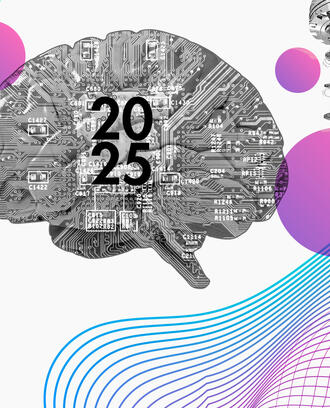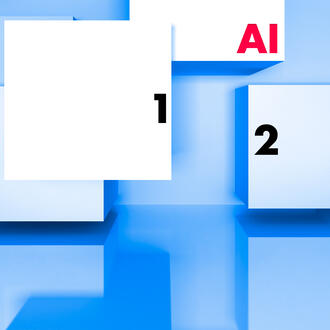Credit: Shutterstock / Bas Nastassia
What business leaders need to know about artificial intelligence
By
Artificial intelligence dominates the headlines, part promise and part specter, as society grapples with how technology is changing the way we work and live.
Both hype about AI’s immediate potential and fear about its effects are exaggerated, according to MIT Sloan professordirector of the MIT Center for Collective Intelligence.
A realistic understanding of artificial intelligence and the promise of robotics, machine learning, and natural language processing is increasingly important for businesses. The 2018 AI Index report found increased interest in the topic around the world, including substantial increases in AI research, investment in AI startups, enrollment in AI college courses, and jobs that require deep learning skills.
“A lot of senior executives and business leaders today are almost desperate to understand how AI may affect their businesses,” said Malone, who teaches a popular executive education course on artificial intelligence and business strategy. “I think leaders are increasingly worried in many cases that if they don’t figure out how to use AI effectively, they’ll be left behind.” Malone said the course emphasizes the history of artificial intelligence and common misconceptions along with how businesses can harness technology.
Malone said the course also tries to give business leaders a level of AI understanding in between a superficial knowledge of buzzwords and the technical know-how of programmers. He compared it to knowledge about how a car works. You don’t have to know how to repair a car in order to know what to do when you have a flat tire or when the car runs out of gas.
In a similar way, business leaders should get a sense of the basics of AI, like how a computer can look at a picture and identify a stop sign, a pedestrian, or a car.
Course details: Artificial Intelligence | Implications for Business Strategy
“That level of understanding is extremely useful in thinking about how to apply [artificial intelligence] in business,” he said. “If all you know is that it’s something like magic, you can’t really think very hard or very far about how to use it in business without talking to a magician. For example, if you don’t know enough, you’ll ask for all kinds of things that can’t be done.”
Beyond a basic understanding of AI — a look behind the magic curtain, so to speak — Malone said it is important to grasp the truth behind some of AI’s promise.
Here’s a look at the current state of AI.
Smart machines can’t necessarily do simple tasks
Intelligent systems are already in use around the world — robots in warehouses, digital voice assistants in homes, credit risk evaluation programs in banks. These technologies have specialized intelligence, Malone points out, and they are capable of performing specific tasks. But artificial intelligence is not yet capable of general intelligence, like the kind humans possess.
Malone cites the IBM Watson program, which can famously defeat even the best human players of Jeopardy, as an example. “You think wow, that machine must be really smart,” Malone said. “But the truth is that the [version of the] program that beat the best players in Jeopardy couldn’t even play Tic Tac Toe, much less chess.”
The version of Watson that dazzled at Jeopardy, like other AI, is highly specialized; in this case, it’s specialized in precisely the task of playing Jeopardy.
“Just because a program can do something that would be hard for humans to do doesn’t mean the same program can do all the other things that would be easier for humans to do,” Malone said. “In many cases, it can’t do very many of those other things at all.” Businesses already using AI are using it for specific tasks, but not for broad problem-solving.
Human-level intelligence is many years away, but machine learning is here now
AI with human-level general intelligence — the ability to drive a car, move packages, and win at Jeopardy, for example — is still far from reality, Malone said, and humans have been misjudging its arrival for decades.
People today often estimate that human-level AI is about 20 years away. But that timeline hasn’t changed since the 1950s, he points out. Back then people also estimated that advanced human-level AI was about 20 years away. “In other words, it’s been 20 years away for 60 years,” Malone said.
“I think we should be very skeptical of anyone who confidently predicts that we’ll have human level AI in the next couple of decades,” he said.
That’s not to say there aren’t significant advances in some areas of AI.
“If you’re going to learn about only one part of AI right now, machine learning is probably the most important one to learn,” said Malone, who also teaches an executive education course about machine learning.
“There’s been very rapid progress in machine learning in the last few years, and it is now the basis for some of the most impressive AI applications we have," he said. “For instance, machine learning is behind Google translate and the applications that transcribe what you say when you dictate a text message. It’s also key to programs for face recognition, self-driving cars, and sophisticated credit risk analysis.”
Artificial intelligence will likely change jobs, but it won’t take them all away
Artificial intelligence prompts strong human emotions, Malone said. The idea that machines will be taking jobs from people is one of the strongest causes for concern. In fact, that anxiety prompted MIT to embark on a multiyear Work of the Future study, which found that automation will have a profound effect on how people work but inequality and job loss are not inevitable byproducts.
Some jobs will undoubtedly disappear because of automation, Malone said, but history indicates that new technology usually creates new jobs as it destroys old ones.
In his book "Superminds," Malone argues that in the future humans and machines will work together to do things that haven’t been done before. Humans will continue to work at jobs that machines can’t, assume new jobs enabled by artificial intelligence, or will continue to do existing jobs because people prefer to have other people do them (like judges, artists, and football players).
“That doesn’t mean we shouldn’t worry about what to do for people who lose jobs and can’t find others during this transition period,” he said. “I think that’s very different than the doomsday scenarios many people are worried about, massive unemployment for a large fraction of the population. I think while that’s theoretically possible, it’s extremely unlikely.”



